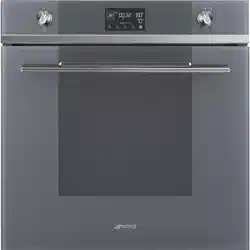Loading ...
Loading ...
Loading ...

USE - 71914779559/C
e
cooking rice, place a lid on the container or
cover with aluminium foil. This procedure
allows the rice to absorb all the water, and it
can then be served directly to the table.
• Eggs: these may be boiled, scrambled or
poached by using the steam function at
100°C. To obtain perfect boiled eggs,
place them on the perforated tray and cook
for 4-6 minutes for soft boiled eggs and 8-
10 minutes for hard-boiled eggs. For
scrambled eggs, place the beaten eggs in
a metal tray together with milk, butter and
seasoning. Cover the tray with aluminium
foil. Mix every couple of minutes using a
fork. For poached eggs, pour boiling water
into the metal tray with a drop of vinegar
and steam cook for around 4-5 minutes.
• Vegetables: steam cooking vegetables
gives excellent results. They maintain their
colour, flavour and nutritional properties. For
dense vegetables such as potatoes, turnips
and parsnips, cook at 100°C for the same
length of time you would boil them on a hob.
For broccoli and carrots, cook for 6 minutes
if you want them to remain firm, or 10
minutes if you want them to be softer.
• Fish: due to the delicate nature of fish,
steaming gives excellent results. For oily fish
such as salmon or trout, cook at 100°C for
around 5 minutes. For white fish such as cod
or haddock, cook at 80°C for around 5
minutes. If you are cooking different foods,
all fish must be cooked in the perforated tray
which must be placed on the bottom shelf of
the oven to avoid liquid from the fish
dripping onto other food products.
• Meat: casseroles and curries are ideal for
steam cooking. Prepare the casserole as for
normal oven cooking. Place it in a metal
tray, cover with a lid or aluminium foil, and
cook for between 45 minutes and 3 hours
depending on the cut of meat used.
• Thin soups: steam cooking allows flavours
to develop perfectly with minimum effort, as
the liquids will not boil over. For vegetable
soup with the correct consistency, first steam
the vegetables, then add broth and steam
cook at 100°C. The steam function is also
ideal for preparing large quantities for later
use.
• Soups: Thicker soups are also easy and
quick to prepare. Place the soup in a metal
tray, cover with a lid or aluminium foil and
steam cook at 100°F for the same time you
would cook it in a microwave oven. To
obtain a creamy texture stir halfway through
cooking.
• Reheating: the steam cooking function will
not dry foods out and gives a moister result.
A previously prepared home-cooked meal,
covered with aluminium foil, will take around
10-12 minutes to reheat. Ready meals will
require approximately double the time
indicated on the package.
• Defrosting: it is possible to use the steam
function to defrost foods. Times vary, but
defrosting with the steam cooking function
takes around half the time necessary for
covered foods left to defrost at room
temperature.
• Peeling peppers and tomatoes: this is very
easy to do when using the steam function.
Use a knife to cut a small cross in the skin of
the tomato, and steam cook for 1 minute.
Peppers have tougher skin, and may require
up to 4 minutes to soften it sufficiently for
peeling.
• Chocolate: this can be melted using the
steam cooking function. Place the chocolate
in a metal tray, cover with aluminium foil and
steam cook for 1 minute. Unlike other
methods, chocolate is unlikely to burn in the
steam oven.
• Hot towels: ideal for facial treatments, a
close shave or for use after a meal, these
are easy to prepare using the steam
cooking function. Moisten a towel with
water, roll it up and steam it for 1 minute.
Combination cooking with steam
1. Turn the knob to the function with steam that
you want to use (e.g
+ ). The
indicator light flashes.
2. Proceed with reservoir filling as described
above.
25% - Cakes and bread
30% - Duck
40% - Beef, veal and lamb
50% - Chicken
70% - Whole fish
Loading ...
Loading ...
Loading ...
